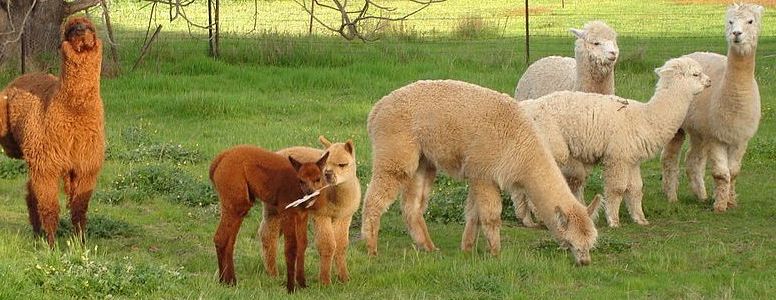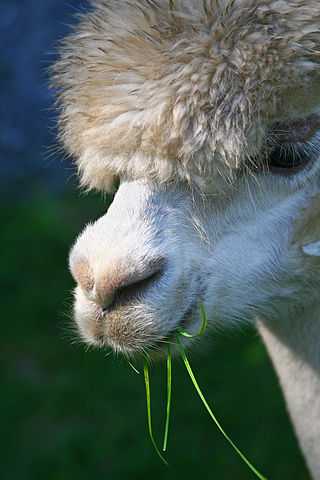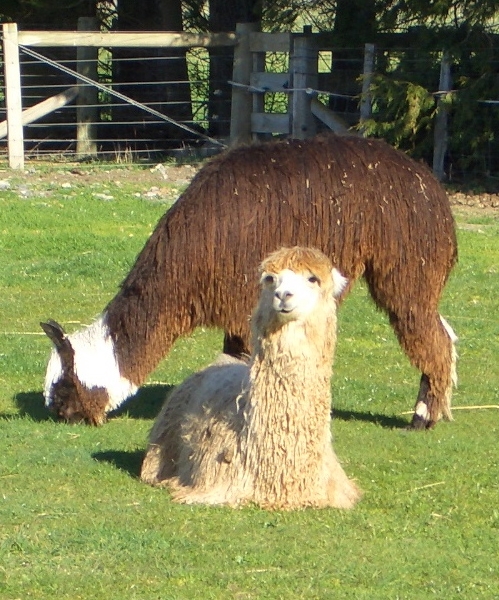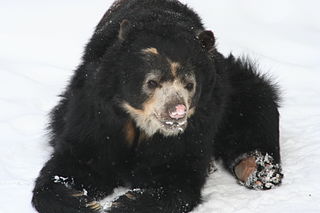
Hmmm... What's for dinner?

What do alpacas eat?
Alpacas are herbivores, or in other words they eat grass and other
vegetation. They are grazing mammals, that are kept in herds, and can
graze all year as long as they are approximately 3,500-5,000 meters
above sea level.(7) The plants they eat are
made up of carbohydrates and can be classified in two
different ways: complex carbohydrates and available carbohydrates.(8)
Complex carbohydrate are grass and alfalfa, because they have cellulose
and hemicellulose. Readily available carbohydrates are in grains like
oats and corn. Like every other animal, alpacas need water.(8)
How do alpacas digest their food?
Alpacas are classified as a pseudoruminants. This is because
alpacas only
have 3 compartments in their stomach, instead of 4 that are present in the ruminants.(11)
Alpacas chew cud, this is food that has been
 regurgitated from the the
first part of their stomach. They chew it in a figure eight motion. They have a different gastrointestinal tract (GIT) than
humans or even different kinds of animals. After the alpacas eat
vegetation, it starts on the long journey through the alpacas
stomach.
regurgitated from the the
first part of their stomach. They chew it in a figure eight motion. They have a different gastrointestinal tract (GIT) than
humans or even different kinds of animals. After the alpacas eat
vegetation, it starts on the long journey through the alpacas
stomach.
The alpacas stomach has 3 different
compartments that all do different things.
Compartment I: This is the largest compartment and this is where fermentation of
the fibrous part of the plant occurs.(11)
Compartment II: This compartment is smaller than compartment I. This is where
digestion is continued by adding buffering agents and more enzymes to the half digested food.(11)
Compartment III: This compartment is similar to the stomach of a
human or dog. Nitrogen is recycled and more enzymes and buffers are
added for digestion like hydrochloric acid (HCl). This is also where
microbes are digested from compartment I and it makes microbial protein;
which is a good source of amino acids.(11)
To read more about the bacteria in the alpacas stomach visit the
interactions page!
By chewing cud and having the three compartmentalized stomach, alpacas get as many nutrients out of the low forage grass as they can. They don't eat that much food compared to other animals; they only need to eat roughly 2% of their body weight to stay healthy. (8) The nutrients are absorbed in the intestine and move into the blood stream. The Alpaca has a closed circulatory system. A closed circulatory system is a system that always has blood circulating in vessels. The blood contains different types of cells and is used for oxygen transport. When alpacas get to many sugars that their body can not use they store it as adipose, or fat tissue.
Poisonous Plants

There are many plants that are poisonous to the alpaca. A few include
arrow grass,
calla lily,
daisies, and many more. Check out
Sierra Nevada Ranch website to see a complete list!
Lions, parasites, and bears oh my!
Alpacas fall prey to carnivorous predators, animals that eat meat,
such as bears, mountain lions,
coyotes, and other animals in the Andes Mountains. Alpacas can be
subject to many different types of parasites, both internal and
external.(12) To read more about this visit
the interactions page.
